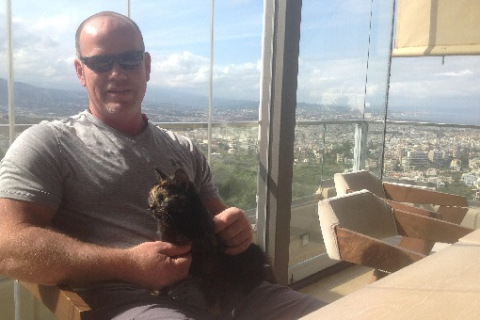Returning to Work Quickly After Mesothelioma Surgery

Written by Travis Rodgers | Edited by Amy Edel | Last Update: 11/12/2025 | 5 Min Read
Shaun Bigbie isn’t letting his recovery from surgery with heated intrathoracic chemotherapy stop him from working or taking care of his mother. Shaun, who is 53 years old, learned he had peritoneal mesothelioma in July 2023.
HITHOC surgery is typically used for pleural mesothelioma patients whose tumors develop on the lining of their lungs. With peritoneal mesothelioma, Shaun’s tumors initially developed on the lining of his abdomen.
Shaun initially underwent surgery with heated intraperitoneal chemotherapy in September 2023. The goal of the HIPEC procedure was to remove visible cancer and target any remaining cancer cells with chemotherapy.
Because of tumor spread (metastasis), about 3 months later Shaun was back in the hospital. Like his previous HIPEC procedure, his HITHOC surgery aimed to remove more cancer and treat his internal organs with heated chemotherapy.
“Being in the hospital for 10 days, I thought this is going to be the worst of it,” Shaun told us. “Then of course the second surgery was 7 days. That week was relatively easier on my body, but once I got out, my chest and my back area was probably the worst part of it.”
Shortly after being in the hospital, he returned to work. He’s also the primary caregiver for his mother.
Returning to Physically Demanding Work After Mesothelioma Surgery
Shaun returned to work the month after surgery to what is a physically taxing job. He works 10 hours a day, 6 days a week and says for the most part he feels great physically.
“I’m a nuclear rigger, many times that includes lifting and handling,” Shaun shares with us. “It can be pretty physical.”
Shaun notes that at 53, he’s younger than the typical mesothelioma patient. He says he’s still active and has always been active.
“At work I’m not doing everything I would normally do, but I’m still at work” he says. “I’m still walking around trying to get my feet back under me so to speak. And it’s taken a while, believe it or not, but I feel like I’m almost there.”
He says he’s still experiencing pain in his chest, but was told that can be an issue for up to 6 months after HITHOC surgery. Shaun says he just works through the pain in his chest and back and is grateful for his co-workers who help him with some of the tasks he isn’t able to perform.
“I’m moving along pretty well,” Shaun shared. “I have good people I work around and they understand there are certain things that I can’t do to because of the risk of hurting myself. But I work with some good people and they look out for me.”
Shaun’s Mother Is His Top Priority
Shaun works 60 hours a week as a nuclear rigger and spends the rest of his time taking care of his mother. He says caring for her is his No. 1 priority.
“I have a lot going on in my life. My mom has Alzheimer’s Disease,” Shaun explains. “I do the best I can to take care of her along with taking care of her yard.”
Shaun continues to help maintain his mother’s 5-acre property by himself. He does all of the yard work and gardening.
“I’m doing the best I can,” Shaun notes. “Slow movements and taking my time because I’m not really in a hurry to get done. I’m putting out mulch even though I’m not 100%.”
But he shares that doing this for his mother is important to him. It’s his way of honoring and caring for her.
“I’m just taking care of her yard and putting things in place where they need to be because she’s done that all of her life,” Shaun said.
Possible Shared Asbestos Exposures Among Family
Unlike many people who are diagnosed with mesothelioma, Shaun is familiar with mesothelioma. His father also had the disease. His dad learned he was sick in 1987 and died just 3 years later in 1990.
Shaun’s father worked at the Ford Motor Company in Norfolk, Virginia. He had also worked at the Norfolk Naval Shipyard in Portsmouth, Virginia. Both are known for a high risk of asbestos exposure.
Shaun tells us that he also worked at both locations where his father had worked. This could mean that he and his father have shared occupational asbestos exposure or primary exposure histories.
There is also a possibility that Shaun experienced secondary asbestos exposure as a child because of his father’s jobs. This is also sometimes called familial asbestos exposure and it happens when a family member wear work clothes, boots or gloves or brings work gear home that has asbestos dust on it. The microscopic fibers can be transferred from the work equipment to family members’ clothing, furniture and upholstery in the home, exposing everyone.
Shaun told the Mesothelioma Center at Asbestos.com, “So they think that somewhere along the line my father brought asbestos on his clothing home to me.” Shaun says his uncle also worked at Ford Motor Company and described the conditions inside of the facility.
“My uncle said there were days where he would see the light shining in through the window and he said you would just see fibers everywhere in the air,” Shaun recalled. “He said that one day it was so bad that they had to shut down the factory and send everyone home.”
Ford used several asbestos automotive products including brakes, clutches and gaskets. Thousands of workers were exposed to the toxic mineral. Since the 1980s Ford Motor Company has been named in thousands of asbestos lawsuits. Cases have resulted in multimillion-dollar verdicts.






